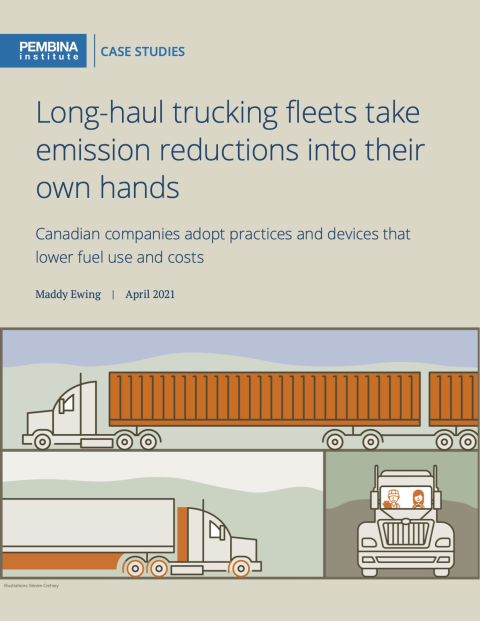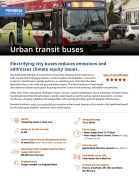Freight trucks play a critical role in our society by ensuring the smooth and efficient movement of goods. In fact, 90% of all consumer products and foodstuffs that move through Canada are moved by freight truck, including 80% of goods that come in from the United States, and more than 60% of our goods that go to the U.S.
The importance of Canada’s trucking industry has been underscored by the COVID-19 pandemic, during which Canadians have relied heavily on trucks to ensure that stores are stocked with the essentials we need — everything from disinfectant wipes and toilet paper to groceries and office supplies.
Freight trucks are also, however, a growing source of greenhouse gas (GHG) emissions. Since 1990, GHG emissions from freight trucks have doubled. They currently represent 37% of Canada’s transportation-related GHG emissions. This includes both the long-haul trips that see bigger trucks travelling city to city or across the country, and the “last-mile” deliveries that count the small and medium-size vans and trucks that bring goods to your neighbourhood or front door.
The Pembina Institute has made recent recommendations for the last-mile or urban delivery sector, as part of our work to decarbonize transportation. We are also keeping close watch on trends, both worrying and optimistic, within long-haul freight.
On the worrying side, long-haul tractor-trailers are expected to contribute disproportionately to the GHG emission profile of the on-road freight sector, as they transport heavier loads over longer distances — thereby consuming more fuel and producing more related GHG emissions.
To meet Canada’s climate target of net-zero carbon emissions by 2050, it is critical that we decarbonize long-haul heavy-duty truck transport. Yet, zero-emission vehicle technologies, like battery electric vehicles and hydrogen fuel cell electric vehicles, which are expected to make a significant impact in the shift to a clean transportation sector, are still potentially years away from being market ready.
But here’s the optimistic side: There is much fleets can do today to reduce their GHG emissions.
A range of solutions
In fact, trucking companies across Canada have already begun to implement a wide range of solutions to reduce emissions from their diesel, heavy-duty vehicles. Many of these practices and devices centre around reducing fuel consumption. By reducing fuel consumption, fleets also end up saving on fuel costs: it’s a win-win for their bottom line and the environment.
Not every solution works for every fleet — much depends on the specifics of a company and its operations. Do they cross provincial or national borders, where changes of regulations may dictate what is allowed or not allowed? Do they stay on main, paved highways or do they drive on gravel and through snowy or difficult conditions?
We found three companies — Musket Transport, Erb Transport and Canadian Tire — that employ different emission-reducing solutions which, in turn, improve their bottom line. They are just a selection of the fleets demonstrating what can be done today.
In interviews with the companies, we found out why they chose the solutions they did and what advice they have to offer other companies.
Musket Transport Ltd: Train drivers to be more fuel efficient
About the company: Musket Transport Ltd., operating predominantly in Ontario and Quebec but also the U.S. since 1993, transports a wide variety of products, from technology, food and sanitation products to large-scale artwork for clients such as shipping companies MSC and Maersk. Its fleet consists of more than 300 class 8 tractor-trailers and straight trucks.
Emission-reduction practice or device: Musket provides training to drivers on fuel-efficient driving techniques, such as reducing acceleration and deceleration, and identifying optimal speeds. Aggressive acceleration and deceleration can contribute to a significant rise in fuel consumption, and so can unnecessary idling and high vehicle speeds.
Why and how the change was made: Musket Transport’s primary motivation was to reduce fuel costs, but as an added bonus, driver training also reduced the company’s environmental impact and helped drivers add specialized training to their resumes. The company adopted the NRCan Smart Driver Highway Training curriculum and administered the program at CHET academy, the company’s in-house driving school.
In their own words: "We are trying to break into different demographics. For example, we really want to involve a lot more females in driver training, and therefore commercial drivers, and same with youth. There aren’t going to be enough people interested in driving a truck because we don't try to bring in those demographics…. So, the fact that [training and technology] make the fleet more green, I think at the end of the day will attract more environmentally conscious people because they recognize that this is the direction the company is going, whether or not individuals want to buy into it, because that is what's currently happening in the future, no matter what.” — Sophia SniegowskiBegidzhanov, corporate communications officer, Musket Transport Ltd.
Bottom line: Drivers could reduce their fuel consumption by up to 35% with fuel-efficiency training.
Canadian Tire: Replace two trucks with one long combination vehicle
About the company: Canadian Tire has been making deliveries since nearly the beginning of the company’s founding. It now has 145 class 8 trucks and delivers across Canada. Most Canadians will be familiar with its goods already — from kitchen appliances to lawn furniture to hockey skates.
Emission-reduction practice or device: A standard long combination vehicle (LCV) replaces two standard tractor-trailers. LCVs are multi-trailer combination vehicles that are particularly well-suited for carriers whose freight tends to cube out rather than weigh out (i.e. is constrained by volume rather than weight limits). By transporting cargo using a single LCV as opposed to two standard tractor-trailers, approximately one-third less fuel is consumed.
Why and how the change was made: With transportation as one of the largest expenses for Canadian Tire, fuel-cost savings were the primary incentive for the switch. Sustainability initiatives, Canadian Tire says, are critical but also have to be win-win: actions that are good for the environment also must make good economic sense. Drivers were required to take an online and practical test, which included in-yard training along with 1,000 km of on-road LCV driving experience with a certified driver. The driver’s safety record also needed to be checked. The company had to apply for permits to operate LCVs. To equip its trailers to operate as an LCV, the company also needed to purchase converter dollies and pintle hooks.
In their own words: “For us, anytime you can move more goods with less tractor power [whether through the adoption of LCVs or longer containers], it’s a huge win. It’s less trucks on the road, and it’s better for the environment, so we’re extremely excited about scaling and maximizing that opportunity.” — Gary Fast, vice-president, transportation, Canadian Tire
Bottom line: With this change, Canadian Tire could achieve fuel savings that translate to a 30% reduction in GHG emissions in comparison to running two trucks. However, a long combination vehicle can’t be used in inclement weather. LCVs are also restricted to certain routes identified as best-suited for LCV transport.
Erb Transport: Combine a range of fuel-saving devices
About the company: Erb Transport started out as a “one-man show” in Ontario back in 1959. The food distributor now distributes across all of Canada and nearly all the U.S. states. It has 650 class 8 tractor-trailers in its fleet, but since many of its trailers require refrigeration, the company faces higher energy demands and also needs to make sure that its refrigeration units have enough airflow whenever it adds new devices to its tractor-trailers.
Emissions-reduction practice or device: Erb Transport has adopted a wide range of fuel-saving devices, including aerodynamic tractors, side skirts, trailer tails, low rolling resistance dual tires, tire pressure monitoring and automatic inflation systems, eco mudflaps, as well as a stationary fifth wheel on the tractor to keep the tractor-trailer gap consistent. These devices help improve the fuel efficiency of a tractor-trailer by reducing drag and rolling resistance. Erb Transport has also transitioned to automated manual transmissions, downspeeded its engines and worked with manufacturers to optimize axle combination to boost fuel efficiency.
Why and how the changes were made: Fuel is one of the company’s biggest costs. Anything beyond fuel savings, such as a reduction in emissions, is an added benefit. The California Air Resources Board requirement that all tractor-trailers travelling within the state be SmartWay certified sparked the widespread adoption of side skirts within its fleets. Because of the success with side skirts, Erb Transport started adopting other fuel-saving devices. The company had to test different technologies to see what worked for its needs. For example, it took a couple of tries before a preferred supplier for side skirts was identified.
In their own words: “With my owner-operators, a lot of them had driven an older classic truck that's not aerodynamic but looks cool going down the road. I was able to show them that if they got one mile to the gallon better with a new truck, they would be able to make their truck payment just with the fuel economy that they're saving. That was probably back when fuel was US$4 a gallon… but honestly, the economic side of saving money is by far the driving force.” — Wendell Erb, president and CEO, Erb Transport
Bottom line: Not every technology will work for every company. For instance, Erb Transport found that trailer tails didn’t work for them; drivers would forget to open them, or they would forget to close them and would cause significant damage to loading dock doors when backing into them. Fuel savings of up to 9% can be achieved with certain combinations of fuel saving devices, according to EPA’s SmartWay.
Next steps: how to ensure long-haul trucking goes the distance
The changes at Musket Transport, Canadian Tire and Erb Transport provide a window into the good that is happening — and is possible — within long-haul trucking in Canada, and the strong business case that exists for the adoption of emissions-reducing practices and devices. Both fleet operators and the wider transport sector, including those involved in setting regulations and standards for the industry, play a part in decarbonizing trucking. Here are three considerations:
- A wide range of effective practices and devices are already available to reduce the fuel consumption and GHG emission output of heavy-duty trucks. Fleet operators can act now to benefit from the fuel cost savings, while doing their part to reduce GHG emissions. Emissions from the freight sector are rising, and while the promise of zero-emission vehicles looms, we may still be years away from market transformation for longer hauls.
- Fleets should take the time to test a few devices and/or practices and find what worksfor them — not every solution will work for every fleet. By looking to their peers, such as those included in this series, fleets can develop a sense of what solutions might be best.
- In order to help accelerate the deployment of fuel-saving devices and practices by fleets, government supports are needed, including financial and non-financial mechanisms such as rebates and regulatory changes.
Illustrations by Steven Cretney








